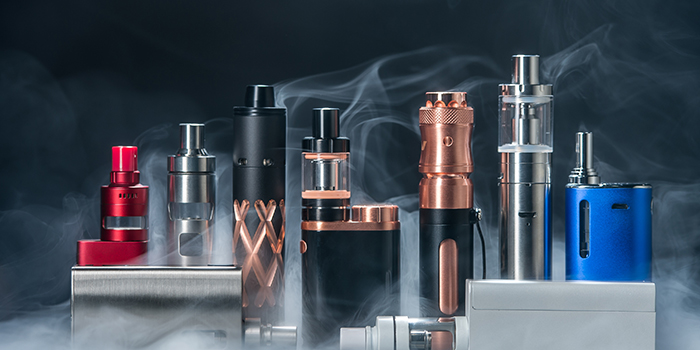
Vaping devices are battery-operated devices that people use to inhale an aerosol, which typically contains nicotine (though not always), flavorings, and other chemicals. They can resemble traditional tobacco cigarettes (cig-a-likes), cigars, or pipes, or even everyday items like pens or USB memory sticks. Other devices, such as those with fillable tanks, may look different. Regardless of their design and appearance, these devices generally operate in a similar manner and are made of similar components. More than 460 different e-cigarette brands are currently on the market.
Most e-cigarettes consist of four different components, including:
- a cartridge or reservoir or pod, which holds a liquid solution (e-liquid or e-juice) containing varying amounts of nicotine, flavorings, and other chemicals
- a heating element (atomizer)
- a power source (usually a battery)
- a mouthpiece that the person uses to inhale
In many e-cigarettes, puffing activates the battery-powered heating device, which vaporizes the liquid in the cartridge. The person then inhales the resulting aerosol or vapor (called vaping).
Vaping devices are popular among teens and are now the most commonly used form of nicotine among youth in the United States. Some research shows that many teens do not even realize that vaping cartridges contain nicotine, and assume the pods contain only flavoring. The easy availability of these devices, alluring advertisements, various e-liquid flavors, and the belief that they're safer than cigarettes have helped make them appealing to this age group. In addition, they are easy to hide from teachers and parents because they do not leave behind the stench of tobacco cigarettes, and are often disguised as flash drives. Further, a study of high school students found that one in four teens reported using e-cigarettes for dripping, a practice in which people produce and inhale vapors by placing e-liquid drops directly onto heated atomizer coils. Teens reported the following reasons for dripping: to create thicker vapor (63.5 percent), to improve flavors (38.7 percent), and to produce a stronger throat hit—a pleasurable feeling that the vapor creates when it causes the throat to contract (27.7 percent).2 More research is needed on the risks of this practice.
In addition to the unknown health effects, early evidence suggests that vaping might serve as an introductory product for preteens and teens who then go on to use other nicotine products, including cigarettes, which are known to cause disease and premature death. A study showed that students who had used e-cigarettes by the time they started 9th grade were more likely than others to start smoking cigarettes and other smokable tobacco products within the next year.3 Another study supports these findings, showing that high school students who used e-cigarettes in the last month were about 7 times more likely to report that they smoked cigarettes when asked approximately 6 months later, as compared to students who said they didn't use e-cigarettes. Notably, the reverse was not true—students who said they smoked cigarettes were no more likely to report use of e-cigarettes when asked approximately 6 months later. Like the previous study, these results suggest that teens using e-cigarettes are at a greater risk for smoking cigarettes in the future.4 Another study has shown an association between e-cigarette smoking and progression to smoking actual cigarettes.5 This study suggests that vaping nicotine might actually encourage cigarette smoking in adolescents.
Additionally, a study of adult smokers in Europe found those who vaped nicotine were less like to have stopped smoking than those who did not. Those who used e-cigarettes also smoked more cigarettes than those who didn’t.6 In another study of more than 800 people who said they vaped to help them quit traditional cigarette smoking, only nine percent reported having quit when asked a year later. However, more research is still needed to understand if experimenting with e-cigarettes leads to regular use of smokable tobacco.
Under U.S. Food and Drug Administration (FDA) regulations designed to protect the health of young Americans, minors can no longer buy e-cigarettes in stores or online (see "Government Regulation of E-cigarettes"). The FDA now regulates the manufacture, import, packaging, labeling, advertising, promotion, sale, and distribution of e-cigarettes. This includes components and parts of e-cigarettes but excludes accessories.
The nicotine in e-liquids is readily absorbed from the lungs into the bloodstream when a person vapes an e-cigarette. Upon entering the blood, nicotine stimulates the adrenal glands to release the hormone epinephrine (adrenaline). Epinephrine stimulates the central nervous system and increases blood pressure, breathing, and heart rate. As with most addictive substances, nicotine activates the brain’s reward circuits and also increases levels of a chemical messenger in the brain called dopamine, which reinforces rewarding behaviors. Pleasure caused by nicotine’s interaction with the reward circuit motivates some people to use nicotine again and again, despite risks to their health and well-being.
Research so far suggests that vaping devices might be less harmful than combustible cigarettes when people who regularly smoke switch to them as a complete replacement. But nicotine in any form is a highly addictive drug. Research suggests it can even prime the brain’s reward system, putting vapers at risk for addiction to other drugs.9
Also, e-cigarette use exposes the lungs to a variety of chemicals, including those added to e-liquids, and other chemicals produced during the heating/vaporizing process.10 A study of some e-cigarette products found the vapor contains known carcinogens and toxic chemicals, as well as potentially toxic metal nanoparticles from the device itself. The study showed that the e-liquids of certain cig-a-like brands contain high levels of nickel and chromium, which may come from the nichrome heating coils of the vaporizing device. Cig-a-likes may also contain low levels of cadmium, a toxic metal also found in cigarette smoke that can cause breathing problems and disease.11 More research is needed on the health consequences of repeated exposure to these chemicals. There are also reports of lung illnesses and deaths related to inhalation of certain vaping oils into the lungs, which have no way to filter out toxic ingredients.
The Food and Drug Administration has alerted the public to thousands of reports of serious lung illnesses associated with vaping, including dozens of deaths. They are working with the Centers for Disease Control and Prevention (CDC) to investigate the cause of these illnesses. Many of the suspect products tested by the states or federal health officials have been identified as vaping products containing THC, the main psychotropic ingredient in marijuana. Some of the patients reported a mixture of THC and nicotine; and some reported vaping nicotine alone. While the CDC and FDA continue to investigate possible other contributing substances, CDC has identified a thickening agent—Vitamin E acetate—as a chemical of concern among people with e-cigarette or vaping associated lung injuries. They recommend that people should not use any product containing Vitamin E acetate, or any vaping products containing THC; particularly from informal sources like friends, family, or in-person and online dealers. They also warn against modifying any products purchased in stores, or using any vaping products bought on the street. People, including health professionals, should report any adverse effects of vaping products. The CDC has posted an information page for consumers.
The teen years are critical for brain development, which continues into young adulthood. Young people who use nicotine products in any form, including e-cigarettes, are uniquely at risk for long-lasting effects. Because nicotine affects the development of the brain's reward system, continued nicotine vaping can not only lead to nicotine addiction, but it also can make other drugs such as cocaine and methamphetamine more pleasurable to a teen's developing brain.
Nicotine also affects the development of brain circuits that control attention and learning. Other risks include mood disorders and permanent problems with impulse control—failure to fight an urge or impulse that may harm oneself or others.
Some people believe e-cigarettes may help lower nicotine cravings in those who are trying to quit smoking. However, e-cigarettes are not an FDA-approved quit aid, and there is no conclusive scientific evidence on the effectiveness of vaping for long-term smoking cessation. It should be noted that there are seven FDA-approved quit aids that are proven safe and can be effective when used as directed.
Vaping nicotine has not been thoroughly evaluated in scientific studies. For now, not enough data exists on the safety of e-cigarettes, how the health effects compare to traditional cigarettes, and if they are helpful for people trying to quit smoking.
- People vape with battery-operated devices used to inhale an aerosol, which can contain nicotine, marijuana, flavorings, and other chemicals. In many e-cigarettes, puffing activates the battery-powered heating device, which vaporizes the liquid in the cartridge or reservoir. The person then inhales the resulting aerosol or vapor (called vaping).
- Vaping is popular among teens. Under U.S. Food and Drug Administration (FDA) regulations designed to protect the health of young Americans, minors can no longer buy e-cigarettes in stores or online.
- Nicotine stimulates the adrenal glands to release the hormone epinephrine (adrenaline) and increases the levels of a chemical messenger in the brain called dopamine. Pleasure caused by nicotine’s interaction with the brain’s reward system motivates some people to use nicotine again and again, despite possible risks to their health and well-being.
- Research so far suggests that vaping is less harmful than combustible cigarettes when people who regularly smoke switch to them as a complete replacement. But e-cigarettes can still damage a person's health.
- Vaping can lead to nicotine addiction and increased risk for addiction to other drugs.
- Vaping also exposes the lungs to a variety of chemicals, including those added to e-liquids, and other chemicals produced during the heating/vaporizing process.
- More research is needed to determine if vaping nicotine can be as effective as smoking cessation aids already approved by the FDA.
This publication is available for your use and may be reproduced in its entirety without permission from NIDA. Citation of the source is appreciated, using the following language:
Source: National Institute on Drug Abuse; National Institutes of Health; U.S. Department of Health and Human Services.


